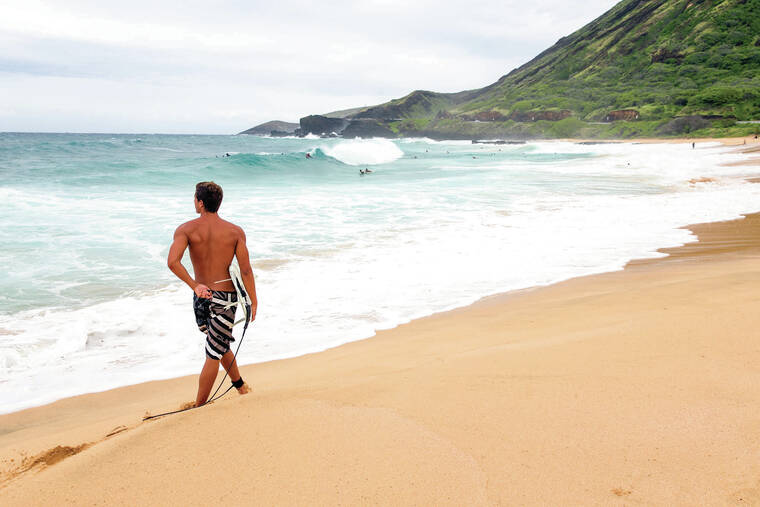Hawaii ocean drownings, rescues rising at remote hot spots
Honolulu lifeguards are responding to swimmers in distress in more places than they used to—and at more remote beaches—than in past years as visitors return to the isles.
Ocean Safety Chief John Titchen says with the increasing popularity of social media, more visitors are going to more remote beaches, many of which have no lifeguard towers, and ending up in spots previously lesser-known.
ADVERTISING
Kahe Point, known more popularly as “Electric Beach ” in Nanakuli, is one example, but other places include Shark’s Cove and Three Tables on Oahu’s North Shore, China Walls in East Honolulu and Kalama Beach along the Kailua Bay shoreline.
“There are a lot of hot spots around the island where we see increased number of visitors because of social media,” Titchen said. “Spots that were exclusively left for those in the know now are more readily available for people who can go on Instagram to find details on how to get somewhere.”
A growing number of rescues also take place at Ko Olina, Ka hana Bay and Kaena Point—and at offshore islets such as the Mokuluas off Kailua.
Spotting this trend years ago, Titchen said Ocean Safety increased its mobile response units to patrol hot spots, but will also add more lifeguard towers.
The top three rescue hot spots on Oahu, however, have remained consistent over the years.
Sandy Beach Park is the No. 1 rescue spot, with an average of 800 rescues per year; followed by Waikiki, at No. 2, with an average of 500 rescues per year; and Hanauma Bay Nature Preserve, at No. 3, with an average of 300 rescues per year over the past three years.
Honolulu Ocean Safety is the city’s primary responder for emergencies on the beaches, covering more than 200 miles of shoreline and near-shore waters out to a mile off Oahu.
Titchen said Ocean Safety partners effectively with Emergency Medical Services, fire and police to respond to 911 calls on beaches.
“We cannot be everywhere at once, so we remind the public to call 911 and lifeguards will be dispatched for any incident near the beach, ” he said.
Drowning among visitors Drowning is the fifth leading cause of fatal injuries among Hawaii residents, according to data from the state Department of Health, behind all types of traffic-related injuries combined, with an average of 48 per year.
However, drowning is by far the leading cause of fatalities among visitors, mostly in the ocean.
From 2013 to 2022 there were 792 total fatal ocean drownings, according to preliminary data from DOH—54 % visitors compared with 46% residents.
In 2020, when travel was restricted, total drownings dipped to 56, well below the average of 79 for those 10 years. As more visitors return to Hawaii without COVID-19 restrictions, the number of drownings is also rising again.
“The fact it’s trending back up again in concert with visitors returning is what we would expect, unfortunately,” said Dan Galanis, epidemiologist with the DOH’s Injury Prevention and Control Section.
Titchen said the demographics now has shifted, with more visitors from the mainland than international visitors. Rescues at Hanauma Bay have decreased, he said, since the reservation system was put in place, limiting the number of visitors.
But places like Electric Beach seem to be getting more calls as more visitors—and locals—flock to it. In 2022 there were 35 emergency calls involving drownings, near drownings or major injuries there, compared with just five in 2013.
There, he said, it is easy to get pushed out by the wind, particularly if one is facedown looking for fish, and to end up farther offshore than planned.
A new lifeguard tower—Oahu’s 42nd—has been budgeted for Kahe Point after advocacy from the local neighborhood board and City Council member Andria Tupola.
It should be installed by the end of the year, Titchen said. A new lifeguard tower is also expected for Kalama Beach in Kailua, but not this year.
Patty Kahanamoku-Teruya, chair of the Nanakuli-Maili Neighborhood Board, said it had been advocating for the lifeguard tower since at least 2019. She welcomes the new tower as soon as possible and hopes it will be staffed.
She said Electric Beach has gotten more popular with visitors as tour companies bring groups to train for diving and snorkeling excursions. Due to its proximity to Ko Olina, it has become a popular alternative when parking is unavailable at the resort beaches.


